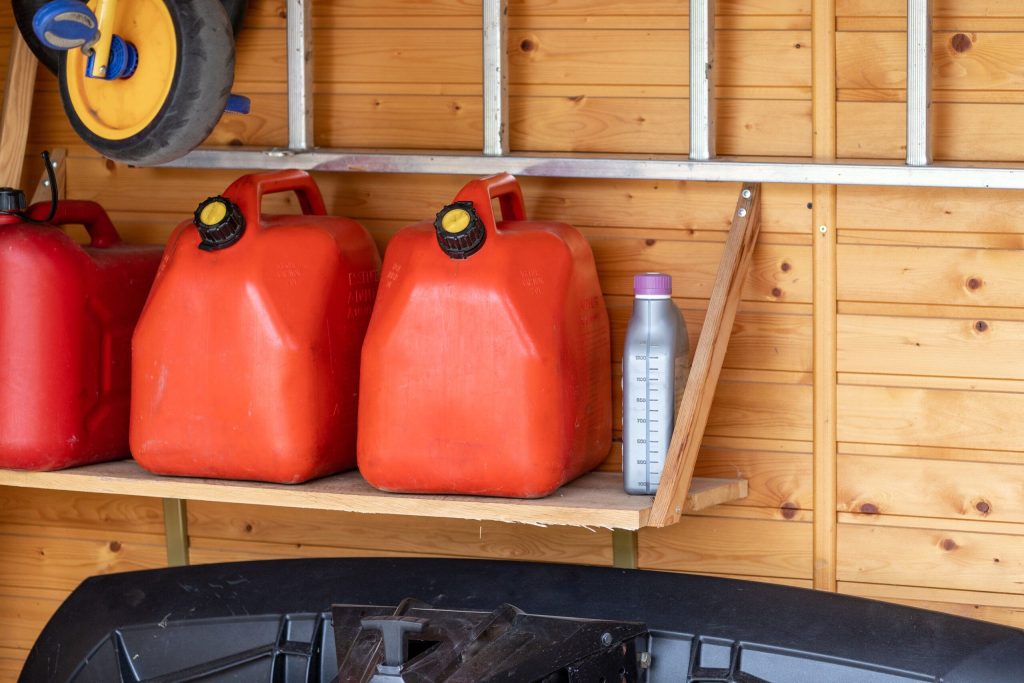How To Dispose of Old Gasoline


We may be compensated if you purchase through links on our website. Our Reviews Team is committed to delivering honest, objective, and independent reviews on home products and services.
More
Gasoline-powered vehicles and equipment are part of our daily lives. However, the petroleum-based fuel that powers them can pose serious health, environmental, and fire hazards if not handled properly. Every homeowner and vehicle owner should understand how to store, use, and dispose of gasoline safely. This guide will walk you through the essential considerations for managing gasoline.
How Long Does Gasoline Last?
Only buy gas when you expect to use before it degrades. Regular gasoline lasts three to six months, premium or high-octane fuel lasts up to nine months, and diesel can last up to a year. However, it can go bad sooner if not properly stored (more on that below).
The fuel in regularly used vehicles and equipment should remain in good condition, but gasoline in less frequently used machines can deteriorate over time.
What Makes Gasoline Go Bad?
Gasoline is primarily composed of hydrocarbons refined from crude oil, along with various chemical additives to enhance stability and prevent corrosion. Despite these additives, gasoline will eventually break down due to evaporation and oxidation, forming a sludgy varnish that can clog fuel systems.
Several factors contribute to gasoline degradation, including the following:
- Alcohol separation: Ethanol in the fuel can separate over time and damage engine components.
- Contamination: Rust, dirt, and other particles can enter the fuel tank.
- Microbial growth: Fungi and bacteria can thrive in stored gasoline, especially when exposed to temperature fluctuations.
- Oxidation: Exposure to air causes chemical changes in the fuel.
- Water absorption: Moisture from the air can mix with the gasoline.
How To Tell If Gasoline Is Not Good
Visual inspection is the most reliable method to determine if gasoline has gone bad. You can also take a quick sniff (not a full breath of fumes). Look for these signs:
- Color and clarity: Fresh gasoline is clear with a slight amber hue. Old gas becomes darker and cloudy.
- Contaminants: Check for rust or foreign particles at the bottom of the tank.
- Odor: New gasoline has a distinct, clean smell. Bad gas may have a musty, sour, or moldy scent.
If you notice any of these signs, we recommend disposing of the gasoline safely rather than risking damage to your engine.
Proper Storage Techniques for Gasoline
Storing gasoline correctly can significantly extend the fuel’s usable life and reduce the risk of accidents.
Best Containers for Gasoline Storage
Always use containers specifically designed and approved for gasoline storage. Modern plastic fuel cans are ideal because they resist corrosion, prevent contamination, and minimize evaporation. They also come in a range of sizes for different needs.
Avoid using old-style metal cans, which can rust and contaminate the fuel. Never store gasoline in glass jars or other unapproved containers.
Ideal Storage Conditions
Follow these tips to maximize the shelf life of your gasoline:
- Store in a cool, dry place away from direct sunlight.
- Keep containers in a separate building from your home.
- Make sure the storage area is well-ventilated.
- Avoid areas prone to temperature fluctuations.
- Keep gasoline away from any potential ignition sources.
Extending the Shelf Life of Gasoline
You can take additional steps to prolong the usable life of your gasoline, especially for equipment you don’t use that often.
Using Fuel Stabilizers
Fuel stabilizers are chemical additives designed to slow down gasoline degradation. They work by minimizing water absorption, slowing hydrocarbon breakdown, and preventing gum and varnish deposits from forming.
Popular brands of stabilizers include Sta-bil, Star Tron, and Sea Foam. These products can extend the life of gasoline for up to a year or more when used correctly.
Rotating Your Gasoline Supply
Date your fuel containers when you fill them, and use the oldest gas first. Refill your supply with fresh fuel periodically to make sure you always have fresh gasoline when you need it. Add stabilizer to gas that you plan to store for extended periods. These measures minimize your risk of using degraded fuel in your equipment.
Safe Disposal Methods for Old Gasoline
Always dispose of old gasoline responsibly to protect the environment and comply with local regulations. Regulations vary from state to state and even town to town, so check local guidelines.
Local Hazardous Waste Facilities
Most municipalities have designated facilities for hazardous waste disposal. There are a couple of ways to find your local facility:
- Check your city or county website.
- Contact your local Department of Public Works.
- Call your town hall for guidance.
Special Waste Removal Events
Many communities organize hazardous waste collection events. These are often free for residents and provide a convenient way to dispose of old gasoline and other chemicals. Check your local government’s website or contact them directly for upcoming event schedules.
Commercial Waste Disposal Services
If you need to dispose of gasoline quickly and can’t wait for a municipal event, you can use a commercial waste disposal service. Be prepared for the potentially high cost.
Transporting Gasoline Safely
Safe transportation of both new and used gas is critical for preventing accidents and spills.
Approved Containers for Transportation
Use only approved gas cans for transporting fuel. These containers are designed to prevent leaks and withstand the pressures of transport. Make sure the cap is tightly sealed before moving the container.
Vehicle Safety Precautions
When transporting gasoline, follow these precautions:
- Never place containers in the passenger compartment of your car.
- Secure cans in an open truck bed or trailer when possible.
- If using a car trunk, make sure there’s proper ventilation and that the containers are tightly sealed.
- Use straps or rope to prevent containers from tipping.
- Remove gas cans from the vehicle immediately upon arrival.
- Always keep gasoline away from heat sources, sparks, and open flames during transport.
Handling Gasoline Spills
Accidents happen, so it’s important to know how to handle gasoline spills safely and effectively.
Immediate Steps To Take
If you spill gasoline, follow these steps immediately:
- Put on fuel-resistant nitrile gloves and safety glasses.
- Quickly spread an absorbent material over the spill.
- Ventilate the area to allow fumes to dissipate.
- Keep all ignition sources away from the spill site.
Cleaning Up Different Surfaces
Follow these tips for nonabsorbent surfaces:
- Use specialized absorbent pads or granules.
- Allow any remaining gasoline to evaporate.
- Clean the area with vinegar to neutralize odors.
- Follow up with a citrus-based cleaner if needed.
Use similar cleanup methods for absorbent surfaces, such as carpet:
- Blot up as much gasoline as possible.
- Use a mixture of baking soda and water to absorb the remaining fuel.
- If the odor persists, consider professional cleaning or replacement.
Dispose of all materials used for cleanup at a hazardous waste facility.
“Recondition” Old Gas at Your Own Risk
The internet is full of videos demonstrating methods for filtering old gas so you can keep using it, sometimes suggesting adding it in small amounts to good gas rather than letting it go to waste. Though many of these people claim they’ve made the old gas “like new” by cleaning out impurities, the stuff they’ve removed is often the remnants of ingredients that made the gasoline a high-quality fuel in the first place. You’d risk doing more damage, or at least getting poor performance, running it in your engine.
Additional Guidance on Managing Gasoline
Stay informed about potential hazards, storage solutions, and disposal methods to reduce risks associated with gasoline.
Recognizing the Signs of Gasoline Leaks
Identifying a gasoline leak early can prevent accidents and environmental contamination. Look for the following indicators:
- Decreased fuel efficiency or unexpected fuel loss in vehicles
- Noticeable gasoline smell around storage areas or vehicles
- Puddles of liquid under vehicles or equipment
Address leaks promptly by inspecting fuel lines, seals, and connections. We recommend professional repair for most gasoline leaks.
Emergency Procedures for Gasoline Fires
Handling gasoline safely includes being prepared for emergencies, such as fires. Knowing what to do can save lives and property:
- Evacuate the area immediately in case of a fire.
- Use a Class B or Class ABC fire extinguisher to control small fires. Never use water on a gasoline fire.
- Contact emergency services for all fires. Emergency responders can put out large fires and inspect areas after small fires to prevent reignition.
- Inform neighbors and bystanders to keep a safe distance.
Regularly check that all fire extinguishers are in working order and that household members know how to use them.
Environmental Impact of Gasoline Disposal
Improper gasoline disposal can have severe environmental consequences. It can contaminate water sources, harm wildlife, and contribute to air pollution. Always follow local regulations and guidelines for hazardous waste disposal.
Our Conclusion
You must manage gasoline properly to maintain your vehicles and equipment while protecting your safety and the environment. By understanding gasoline’s lifespan, proper storage, and safe disposal, you can minimize waste and potential hazards.
Remember that the best approach is to buy only the gasoline you need and use it while it’s fresh. When in doubt about the quality of your fuel or the best disposal method, consult local authorities or professional services.







